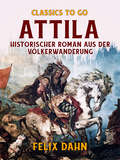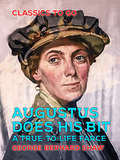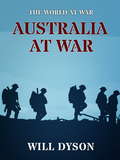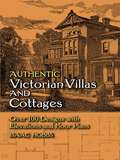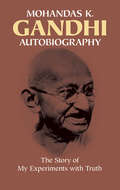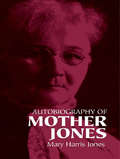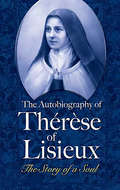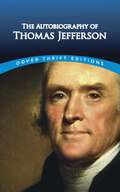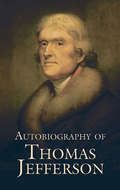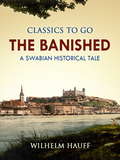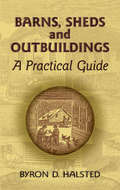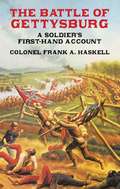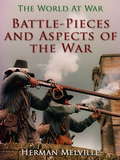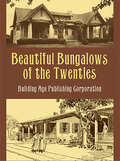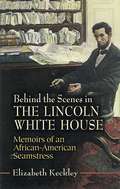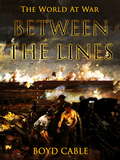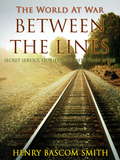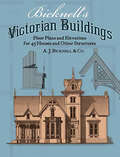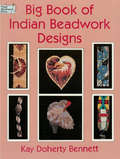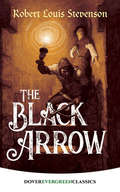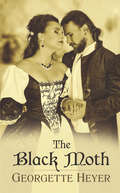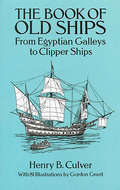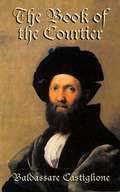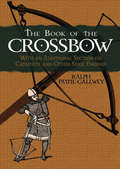- Table View
- List View
Attila Historischer Roman aus der Völkerwanderung (Classics To Go)
by Felix DahnAttila († 453) war von 434 (als Mitherrscher zusammen mit seinem Bruder Bleda) bzw. 444/45 (als Alleinherrscher) bis zu seinem Tod „König“ (rex) des Kriegerverbandes der Hunnen. Zentrum seines Machtbereichs war das Gebiet des heutigen Ungarns, wo die Hunnen im 5. Jahrhundert ein kurzlebiges Reich errichteten, das unter Attila die größte Machtentfaltung erlebte, aber bereits kurz nach seinem Tod wieder zusammenbrach. (Wikipedia)
Augustus Does His Bit A True-to-Life Farce: A True-to-life Farce (The World At War)
by George ShawAugustus Does His Bit, A True to Life Farce (1916) is a comic one-act play by George Bernard Shaw about a dim-witted aristocrat who is outwitted by a female spy during World War I. (Google)
Australia at War: A Winter Record On The Somme And At The Ypres During The Campaigns Of 1916 And 1917 (The World At War)
by Will DysonA winter record made by Will Dyson on the Somme and at Ypres during the campaigns of 1916 and 1917; with an introduction by G.K. Chesterton.
Authentic Color Schemes for Victorian Houses: Comstock's Modern House Painting, 1883
by E. K. Rossiter F. A. WrightWhen the authors, a pair of respected architects, first published this beautiful book in the late Victorian era, they meant it as a wakeup call to the forward-looking homeowners of the time — inviting them to eschew "the old puritanical hatred of color, which found its natural outcome in white houses with green blinds" and join in the revolutionary trend toward "advanced notions, in which the more positive colors find a chance of expression." The book helped homeowners to attain this goal through its presentation of full-color illustrations of attractive, up-to-date color schemes for houses, with special attention given to the refined lines of Queen Anne-style homes.The heart of the book is the section of 20 exquisite color plates — each reproducing a flawlessly executed architectural drawing that shows the color possibilities for a specific house, and each accompanied by an extensive written description of the colors to be used for exterior walls and trim. An informative introductory section gives a clear explanation of how to mix primary and secondary colors to achieve such popular, mellow tones of the period as olive, russet, citrine, buff, plum, and sage. This authentic source of inspiration and suggestions will be prized by restorationists, architects, home-builders, and lovers of Victoriana.
Authentic Victorian Villas and Cottages: Over 100 Designs with Elevations and Floor Plans
by Isaac H. HobbsMore than 100 magnificent home plans provide lovers of Victoriana the finest examples of period architecture. Compiled by Isaac Hobbs, a prominent Philadelphia architect of the period, the book also offers an informative discussion on the principles and practices of practical home design and construction. Designs and floor and ground plans for villas, cottages, and other residences are revealed in 122 detailed engravings, among them a six-room ornamental cottage (without bathroom facilities) for $1,500; an elegant Elizabethan villa, with entry hall, library, china closet, and five bedrooms, for $27,000; and an ornate Gothic suburban residence, complete with parlor, sitting room, dressing rooms, six bedrooms, and two bathrooms, at a cost of $33,000.Invaluable to architects, preservationists, and home restorers, this authentic guide to a wealth of house styles from the late 1800s will also delight anyone intrigued by Victorian life.
Autobiography: The Story of My Experiments with Truth
by Mohandas Gandhi"My purpose," Mahatma Gandhi writes of this book, "is to describe experiments in the science of Satyagraha, not to say how good I am." Satyagraha, Gandhi's nonviolent protest movement (satya = true, agraha = firmness), came to stand, like its creator, as a moral principle and a rallying cry; the principle was truth and the cry freedom. The life of Gandhi has given fire and fiber to freedom fighters and to the untouchables of the world: hagiographers and patriots have capitalized on Mahatma myths. Yet Gandhi writes: "Often the title [Mahatma, Great Soul] has deeply pained me. . . . But I should certainly like to narrate my experiments in the spiritual field which are known only to myself, and from which I have derived such power as I possess for working in the political field." Clearly, Gandhi never renounced the world; he was neither pacifist nor cult guru. Who was Gandhi? In the midst of resurging interest in the man who freed India, inspired the American Civil Rights Movement, and is revered, respected, and misunderstood all over the world, the time is proper to listen to Gandhi himself — in his own words, his own "confessions," his autobiography. Gandhi made scrupulous truth-telling a religion and his Autobiography inevitably reminds one of other saints who have suffered and burned for their lapses. His simply narrated account of boyhood in Gujarat, marriage at age 13, legal studies in England, and growing desire for purity and reform has the force of a man extreme in all things. He details his gradual conversion to vegetarianism and ahimsa (non-violence) and the state of celibacy (brahmacharya, self-restraint) that became one of his more arduous spiritual trials. In the political realm he outlines the beginning of Satyagraha in South Africa and India, with accounts of the first Indian fasts and protests, his initial errors and misgivings, his jailings, and continued cordial dealings with the British overlords. Gandhi was a fascinating, complex man, a brilliant leader and guide, a seeker of truth who died for his beliefs but had no use for martyrdom or sainthood. His story, the path to his vision of Satyagraha and human dignity, is a critical work of the twentieth century, and timeless in its courage and inspiration.
Autobiography of Mother Jones
by Clarence Darrow Mary Field Parton Mary Harris JonesAmong the most stirring works of labor history ever written, this autobiography of Mother Jones (née Mary Harris) chronicles the life of a woman who was considered a saint by many, and by others, "the most dangerous woman in America." A forceful and picturesque figure in the American labor movement of the late nineteenth and early twentieth centuries, Mother Jones was a born crusader.Widowed at the age of 30 when her husband and four young children died during a yellow fever epidemic, Mother Jones spoke out tirelessly and effectively for the rights of workers and unionists. She played a significant role in organizing mining strikes in West Virginia and Colorado, as well as the Pittsburgh steel strike of 1919. She was instrumental in the formation of the United Mine Workers union (UMW) in 1890 and the Industrial Workers of the World (IWW) in 1905.
The Autobiography of Thérèse of Lisieux: The Story of a Soul
by Thérèse Of Lisieux"Our Lord does not look so much at the greatness of our actions, nor even at their difficulty, but at the love with which we do them." -- Saint Thérèse of LisieuxOne of the greatest spiritual classics ever written, this influential autobiography has been translated into nearly every language, capturing hearts and minds around the world. Simply written in clear, enchanting prose, this memoir reveals the path to true inner peace, for "Our Lord needs from us neither great deeds nor profound thoughts. Neither intelligence nor talents. He cherishes simplicity."Born in France, young Thérèse Martin (1873-1897) entered the Carmel Convent of Lisieux at the age of fifteen. Also known as "the Little Flower," her autobiography, written at the request of her Carmelite Superiors in the last years of her life, includes poignant girlhood recollections and her teachings of "the little way of childhood." The "little way," inspired by the Gospel, places love at the very center of every action we take. Traditional yet unique, delicate yet heroic, Thérèse taught a shining spirituality that could easily be adapted into everyday life. Her divine words of acceptance and love are universal, and have gently led many people -- both within the Catholic Church and outside of Christianity -- back to their faith.Saint Thérèse was canonized by Pope Pius XI in 1925. In 1997, she was proclaimed a Doctor of the Church by Pope John Paul II.
The Autobiography of Thomas Jefferson
by Thomas JeffersonDuring his remarkable lifetime, Thomas Jefferson (1743–1826) served his country in many capacities, including as the third President of the United States. But ultimately, this gifted individual — an accomplished architect, naturalist, and linguist — wished to be remembered primarily as the writer of the Declaration of Independence.In this autobiography, begun in 1821 when the author was 77, Jefferson touches fleetingly upon his early years before focusing on the period during which he wrote the Declaration. This edition features a fascinating first draft of the document, in addition to Jefferson's comments on the Articles of Confederation. Other highlights include his firsthand observations on the early stages of the French Revolution, obtained while serving as Minister to France, as well as insights from his many other public roles: wartime Governor of Virginia, Washington's Secretary of State, and Vice President during the John Adams administration. This brief memoir provides a rare opportunity to share the reflections of a Founding Father as written in his own words.
Autobiography of Thomas Jefferson (Mobi Classics Series)
by Thomas JeffersonDuring his remarkable lifetime, Thomas Jefferson (1743–1826) served his country in many capacities — among them, as President of the United States. But ultimately, this great and talented man — an accomplished architect, naturalist, and linguist — wished to be remembered primarily as the author of the Declaration of Independence.In his autobiography, begun in 1821 at the age of 77, Jefferson presents a detailed account of his young life and the period during which he wrote the Declaration. A first draft of the document is included in this edition, as are his comments on the Articles of Confederation, his experiences as a wartime governor of Virginia, minister to France and observations during the French Revolution. Also featured here are rich remembrances and insights as Jefferson recalls his roles as Washington's secretary of state and vice president under John Adams, and his life in retirement.Fascinating as a trove of firsthand recollections by a pillar of American democracy, this highly recommended volume will be welcomed by students, scholars, and any reader interested in American history.
The Banished: A Swabian Historical Tale, Volume 3 (Classics To Go)
by Wilhelm HauffExcerpt: "The events which are recorded in the following pages, took place in that part of Southern Germany situated between the mountainous district of the Alb and the Black Forest. That portion of territory is bounded by the former on the north-west, by a long chain of hills of unequal height and breadth, extending southward, whilst the forest, commencing from the sources of the Danube, stretches uninterruptedly to the banks of the Rhine. Being composed of woods of black pine, it forms a dark background to the beautiful picture produced by a luxuriant country,rich in vineyards and watered by the Neckar, which flows through it.
Barns, Sheds and Outbuildings: A Practical Guide
by Byron D. HalstedAccompanied by more than 250 illustrations, Halsted's environmentally sensitive manual was written with the farmer in mind — and during a time when a laborer earned a mere dollar a day. His barn-building theories extend to dog- and bird-houses, and are based upon qualities we still hold dear: light and air, space, cost, and beauty, as well as permanence, convenience, and workability.This facsimile edition of the 1881 book of plans and instructions will engage the reader with its anecdotal style. Nearly 100 structures span the gamut of farm buildings: from monumental barns--four stories high and covering nearly an acre, to lowly hen coops and root cellars. The particulars of their construction, recounted in simple and practical terms, tell a timeless tale of life lived amid the changing seasons and the natural world.
The Battle of Gettysburg: A Soldier's First-Hand Account (Civil War)
by Frank A. HaskelThe bloody, three-day battle of Gettysburg in the summer of 1863 resulted in thousands of casualties on both sides. Considered the turning point of the Civil War, the campaign rallied the Union troops. A few weeks after the epic military confrontation, Colonel Frank Haskell, a member of the Army of the Potomac, wrote his brother in Wisconsin a highly moving account of what he had experienced. It was perhaps the longest, most poignant letter to a relative from a soldier in the Civil War. Some 45 years later, his comments appeared in book format; this volume is a reprint of that rare edition. In this keenly observed narration, Haskell vividly describes each day's events and what they wrought: the wounded, the skirmishes, attacks and counterattacks, estimates of losses, marks of battle, and burial of the dead. Of the crests in Gettysburg known as Cemetery Ridge, he writes: "Men looked like giants there in the mist, and the guns of the frowning batteries so big, that it was a relief to know that they were our friends." On the second day of battle, he lost his horse "Billy" to a bullet that just missed Haskell's left leg. Mentally, he "begged [Billy's] pardon for spurring him." On the last day, he notes: "The Rebel guns make no reply to ours, no charging shout rings out to-day . . . the jostling, swaying lines on either side boil, and roar, and dash their flamy spray, two hostile billows of a fiery ocean. . . . The frequent dead and wounded lie where they stagger and fall . . . and none can be spared to care for them." He helped bury the dead that day and ended his letter on a note of hope, speaking of a future in which the Union would "repose in a securer peace and bloom in a higher civilization." Almost a year later — on June 3, 1864, at Cold Harbor, Virginia — Colonel Haskell was killed in action. He was 36 years old. One of the war's best eyewitness accounts, this classic narrative, required reading for students of American history, will be treasured by Civil War buffs.
Battle-Pieces and Aspects of the War: Civil War Poems (The World At War)
by Herman MelvilleBattle-Pieces and Aspects of the War (1866) is the first book of poetry published by American author Herman Melville. The volume is dedicated "To the Memory of the Three Hundred Thousand Who in the War For the Maintenance of the Union Fell Devotedly Under the Flag of Their Country" and its 72 poems deal with the battles and personalities of the American Civil War and their aftermath. (Excerpt from Wikipedia)
Beautiful Bungalows of the Twenties
by Building Age Pub.This handy reference displays a variety of handsome bungalows built in the early 1920s from Maine to California. Included are illustrations of charming bungalows for a small family, a farm bungalow with a novel siding treatment, a stucco bungalow design, a chalet in Los Angeles, and other models. 43 double-page spreads of halftones and line illustrations.
Behind the Scenes in the Lincoln White House: Memoirs of an African-American Seamstress (Civil War)
by Elizabeth KeckleyBorn a slave in Virginia, Elizabeth Keckley (c. 1824–1907) went on to become a talented dressmaker and designer, with some twenty employees of her own. Catering to the wives, daughters, and sisters of Washington's political elite, she included among her clientele Mary Todd Lincoln, who became her close friend and confidante.Keckley's behind-the-scenes view of wartime Washington not only provides fascinating glimpses of nineteenth-century America, but also offers candid observations on interracial relationships and the free black middle class. Here also are absorbing details of life in the Lincoln White House, as well as an insider's perspective on the men who made Civil War politics and the women who influenced them. A touching and revelatory work, filled with incisive social commentary, this inspiring narrative by an admirable woman will be an important addition to the libraries of anyone interested in African-American and Civil War history.
Between the Lines (The World At War)
by Boyd CableThis book has been written at the Front within sound of the German guns and for the most part within shell and rifle range It is an attempt to tell something of the manner of struggle that has gone on for months between the lines along the Western Front in WW I.
Between the Lines / Secret Service Stories Told Fifty Years After: Secret Service Stories Told Fifty Years After (The World At War)
by Henry SmithFor those interested in the nitty gritty of the Civil War. It is hard to imagine living at a time and in a place where you were not sure where you and your friends stood. (Excerpt from Goodreads)
Bicknell's Victorian Buildings: Floor Plans and Elevations for 45 Houses and Other Structures
by A. J. BicknellBy the 1880's, American architecture had turned to a heavily formal, almost grandiose style, forsaking the more delicate ornamentation and graceful line of the previous decade. Just prior to the shift, A. J. Bicknell & Co. published a handsome volume of contemporary designs, plans and specifications for a wide range of public and private buildings from many parts of America. Their intention was to feature a complete village which could be constructed at moderate cost; in fact they published one of the last inclusive documentations of that style of mixed Gothic, Romanesque and classical cornices, pedestals, spires and gables known as "Victorian."Forty-five buildings of all sorts -- cottages, villas, suburban houses, town houses, a farm, a jail, courthouses, banks, store fronts, churches, schools, even stables -- are portrayed in beautiful architectural drawings of scaled elevations and floor plans. Large-sized details show the principal corners, panels, railings, arches, finials, window and verandah sections; scales range from 3/32 of an inch to the foot for the elevations, to 1/2"/1' for the details.The designs come from architects in Boston, Philadelphia, Chicago, St. Louis, Nashville, and were built in many large and small communities. Along with the private homes and standard public buildings, there are plans for the first completely fireproof courthouse (built of marble and cast iron) in the United States, at Macoupin County, Illinois; the Bay County Courthouse in Bay City, Michigan, may also be numbered among the noteworthy inclusions. A three-story home in this book, with four bedrooms, dining room, kitchen, parlor, verandah, hall, portico, and cellar (with servants' quarters, if necessary) cost, at that time, $5000 to build; a series of specifications, both general and particular (for carpenters, plumbers, painters and masons) and sample contracts (with provisions for bad weather and striking workmen) offer some idea how such buildings were possible at such prices.The detailed measurements and specifications provide modellers, miniaturists, set designers, woodworkers, or even full-scale builders, with the information necessary to recreate these designs. Historians of architecture, home restorers, anyone who delights in the felicities of American Victorian, will find this book a superb primary source of authentic building style.
Big Book of Indian Beadwork Designs
by Kay Doherty BennettOver the centuries, Native Americans have used beadwork to ornament clothing and a wide variety of ceremonial and utilitarian articles. Now you can create colorful, interesting designs of your own with this beadwork design treasury featuring scores of Indian motifs: buffalo, kachinas, eagles, feathers, lightning bolts, and more. While many of the patterns appear in color-coded charts for beadwork, others can be used in appliqué and embroidery projects, as patterns for stained glass creations, and in numerous other crafts. Easy-to-follow diagrams enable even beginners to create a striking array of gorgeous authentic motifs that will add rich, ornamental touches to T-shirts, vests, blouses, handbags, belts and headbands, cushion covers, table linens, and many other items. An inexpensive way to create beautiful gifts for friends and family, this user-friendly design book will also introduce you to a time-honored craft practiced for centuries by the first Americans.
The Black Arrow: A Tale Of The Two Roses (Dover Children's Evergreen Classics)
by Robert Louis StevensonSet in England during the fifteenth-century Wars of the Roses, this swashbuckling historical novel by the author of Treasure Island and Kidnapped tells the story of young Dick Shelton. Betrayed by his treacherous and brutal guardian, Sir Daniel Brackley, Dick seeks the help of John Amend-All, leader of the mysterious fellowship of the Black Arrow—and Brackley's sworn enemy. Pitted against fierce fighters, a treacherous priest, and Sir Daniel, Dick seeks to become a knight and rescue his true love. Brimming with adventure, suspense, and romance, this thrilling tale presents a classic portrait of England during one of its most tumultuous eras, as Dick is pulled by his loyalties to the houses of both York and Lancaster. He must make a crucial choice, for his fate and the fate of England hang in the balance.
The Black Moth
by Georgette HeyerWhen Lord Jack Carstares is falsely accused of cheating at cards, the young nobleman accepts the blame to protect his brother. Alone and friendless in his European exile, Jack is obliged to develop his skills as a swordsman — an accomplishment he puts to use upon his return to England, where he embarks upon a new career as a highwayman. Chivalrous Jack, like Robin Hood, steals only from the rich and shares his loot with the needy. And when he foils the attempted kidnapping of raven-haired beauty Diana Beauleigh, his rescue sets the stage for a thrilling romance and a chance at redemption.Georgette Heyer's debut novel, written as a diversion for her ailing brother, abounds in the qualities that make her books perennial favorites with lovers of historical romance: colorful characters, sparkling dialogue, and lively plotting punctuated by swashbuckling action. Set in the 1750s, The Black Moth is rich in Georgian-era atmosphere, offering a compulsive page-turner.
The Book of Old Ships: From Egyptian Galleys to Clipper Ships
by Henry B. CulverOf all the ships human beings have constructed to navigate the waters of the world — from a hollowed-out log sharpened at both ends to modern ocean liners weighing thousands of tons — those powered by the wind are among the most interesting and beautiful.In this classic review, noted maritime artist Gordon Grant has created 80 magnificent line illustrations of some of history's most important sailing ships, beginning with a graceful Egyptian galley (c. 1600 B.C.) and ending with a splendid five-masted clipper ship of 1921. Also depicted are a Roman trireme, a Viking longship, a sixteenth-century caravel, an East Indiaman of 1750, an early nineteenth-century brigantine, a New Bedford whaling bark, and dozens of lesser-known vessels, among them the galleass, carrack, buss, and flute.Henry B. Culver, well-known authority on naval history, has provided a detailed, meticulously researched text for each vessel, describing the materials and details of construction, how the ship's design matched its function, the period in which the vessel flourished, romance and lore surrounding the craft, and more. Naval historians and model shipbuilders will value this work as an excellent sourcebook and reference with much information on the evolution of sailing vessels, the origins of shipping, customs of the sea and other pertinent matters; sailing enthusiasts will find it a wonderful browsing book, offering an informative, handsomely illustrated look back at 3,000 years of sailing history.
The Book of the Courtier
by Baldassare CastiglioneWidely acknowledged as the sixteenth century's most significant handbook on leadership, The Book of the Courtier offers an insider's view of court life and culture during the Renaissance. Set in 1507, when the author himself was an attaché to the Duke of Urbino, the book consists of a series of fictional conversations between members of the Duke's retinue. All aspects of leadership come under discussion, but the primary focus rests upon the relationship between advisors and those whom they counsel. Ever-relevant subjects include the decision-making process, maintaining an ethical stance, and the best ways of interacting with authority figures. Frequently assigned in university courses on literature, history, and Renaissance studies, the Dover edition of this classic work will be the lowest-priced edition available.
The Book of the Crossbow: With an Additional Section on Catapults and Other Siege Engines
by Ralph Payne-GallweyThis fascinating study, the only book devoted exclusively to the crossbow, traces its use as a military and sporting weapon as well as its construction and management in medieval and modern times. The work also covers such related weapons as the balista, catapult, Turkish bow, and more. Over 240 illustrations.
